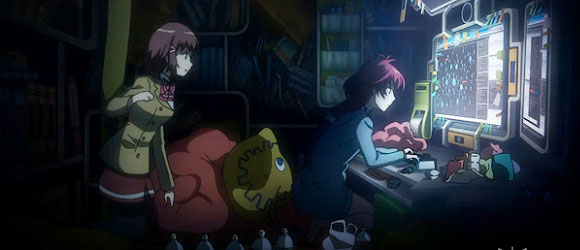Technology and Anime, a Beautiful Love Story
Essay

It’s 2014. It’s Saturday afternoon and I’m checking my queue on Crunchyroll to see if some of the anime series I’ve been following this season have been updated. Technology has altered the way I consume anime, and sitting in front of my computer is a far cry from my childhood self sitting in front of the TV in 1985. I desperately waited for the next episode of Robotech to air because I wanted to see if Rick Hunter would choose Lin Minmay or Lisa Hayes. Of course, my 10 year old self had no idea that Robotech was actually culled from a Japanese animated series called Super Dimensional Fortress Macross and the whole saga was stitched together from three different series to make the 65 episode count for daily syndication.
I just wanted my love triangle and my mecha space battles, okay?

Starting in the 1960s, anime (or “Japanimation” as it was often called) was dubbed into English by American companies with the same cheesy overacting which accompanied Godzilla movies. By the 1980s, dubbing fared a little better, but there were still edits and changes for content. If you wanted to watch a show when you wanted and in a quality that was slightly better than broadcast TV, you’d have to rent or purchase the show on VHS.
Remember VHS? Remember the thrill of being able to watch a television show on your terms instead of waiting for it to air? Remember how the VCR was supposed to herald the end of the motion picture industry because no one would go to see movies in theaters anymore? Remember how that didn’t happen because the movie studios discovered they could make a ton of money from home video sales and rentals?
Despite the convenience of home video technology, buying anime on VHS was incredibly pricy. You first had to decide whether you wanted the subtitled version or the dubbed version. Unlike DVDs or Blu-rays, tapes came with subs or dubs only. And with tapes that only held 2-4 episodes each, one had to be incredibly patient (and fairly rich) in order to complete an entire series of roughly 24 episodes. And woe is you if you got into a series which ran into the dozens or even hundreds of episodes. Companies would also stop releasing new tapes if they didn’t believe the sales justified the cost of producing all those VHS copies. And you still ran into translation issues and edits. Fans who wanted accuracy had to go through other means to get it.
If you wanted something other than what was airing on broadcast television and what was being released by the burgeoning anime companies, you had to seek out other fans. High quality laserdiscs were imported from Japan and enterprising fans would use professional subtitling machines to translate episodes for non-Japanese speakers.
Distribution of fansubs before high speed internet was an interesting affair. With most of us still on dialup, it was next to impossible to get fansubs by downloading them. Therefore, unofficial distributors kept lists of anime they had on videotape from fansub groups. You could peruse the lists, choose which titles to get, and then make requests, sending a videotape so that the distributor could make a copy. It was piracy, but with an honor system. If any money was exchanged at all, it was only to cover the cost of shipping, and a videotape if you didn’t choose to mail one to the distributor to use. Fans, no longer reliant on what was broadcast or what was available for purchase, were controlling what they wanted to see.
Eventually, faster connections meant easier ways of distribution. Now there was the Internet, and now the fans were in control. Peer to peer file-sharing became a main distribution point for fans to get new anime content. I myself remember popping into various IRC channels just to find digitized versions of anime titles. it still took hours and hours to download a single 23 minute episode via IRC, but eventually that gave way to Bittorrent, and even faster ways of sharing content.
With the piracy problem growing (and with anime fandom increasing in popularity in the US), Japanese animation companies had to figure out a way to regain control of it, and most importantly make money from it. Enter simulcasting. What began as an experiment with a handful of anime shows has become the main distribution channel for anime today.
Most current anime series are available for simulcast, and with this rise in accessibility comes an increase in variety. While the market in the past relied on series which were successful (everyone likes giant robots, right?) and ignored titles which piqued niche interests, streaming makes distribution cheap enough to allow for more series to be featured. Want a show about teen friendship? Check. A show about girls wanting to become pop idols? Tons of those. A show about a high school boys swim club?

Oh…yes… Free! Iwatobi Swim Club is a title with a large female fanbase, and it’s definitely not something an anime company would take a chance on releasing on DVD for fear of a lack of broad appeal. But fans found Free! because of streaming, and anime fandom has become much more global because of the Internet. Fans in the US can finally keep up with the latest trends coming directly from Japan.
Streaming is fast and reliable, and free, thanks to advertising. Most titles are available within 24 hours of broadcast in Japan. One can now peruse Crunchyroll or Funimation or Hulu and find subbed anime which had aired within the week. Long gone are the days where fans had to wait years to see the finale of their favorite series. Now it’s nearly instantaneous, but watching the shows at the same time as Japan comes with another problem.
Waiting from week to week is now the hardest part.
And don’t get me started on manga.
Michelle Villanueva was born in Hawai’i but moved to northern California in search of adventure and less humid climes. She lives in the San Francisco Bay Area and enjoys a plethora of nerdy things, particularly anime, comics, and Doctor Who. She’s still waiting for her Hogwarts letter. You can find her on Twitter @Gallifreygal63, and on Tumblr.
Are you following The Mary Sue on Twitter, Facebook, Tumblr, Pinterest, & Google +?
Have a tip we should know? [email protected]